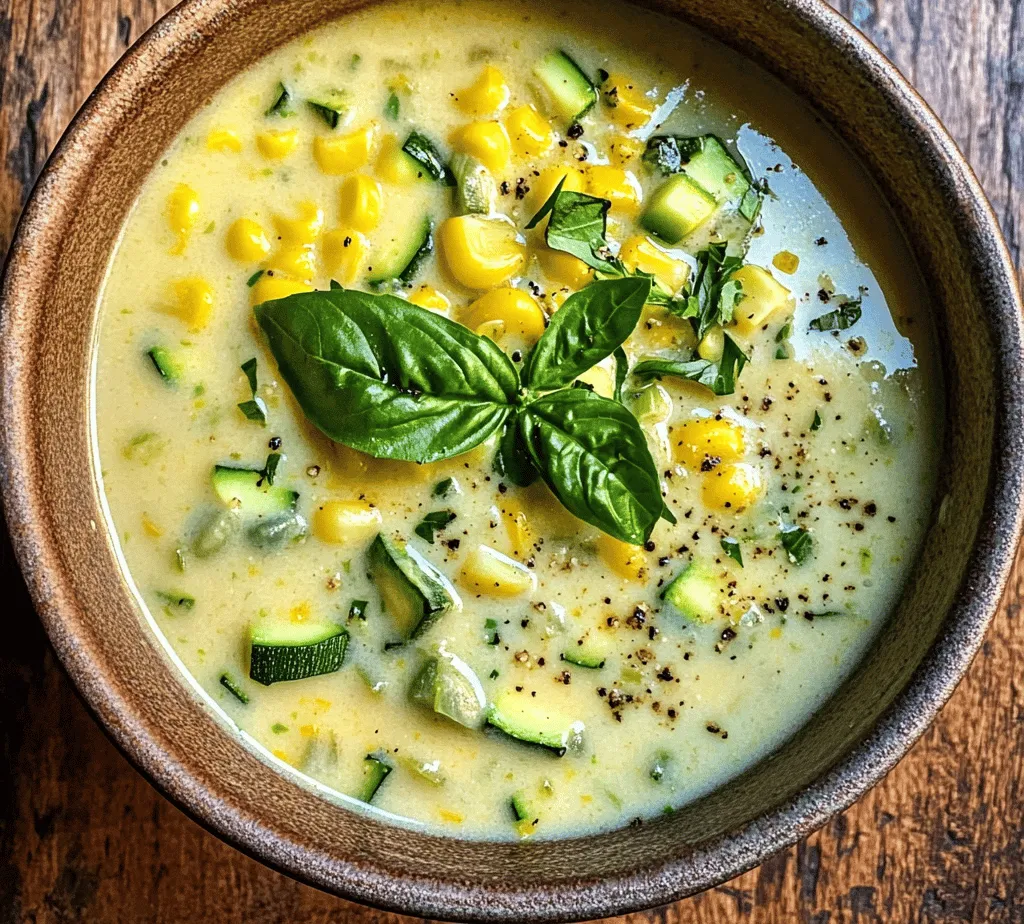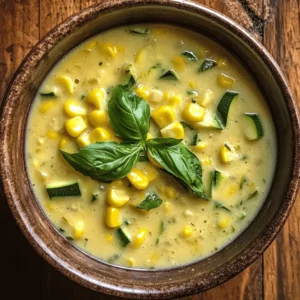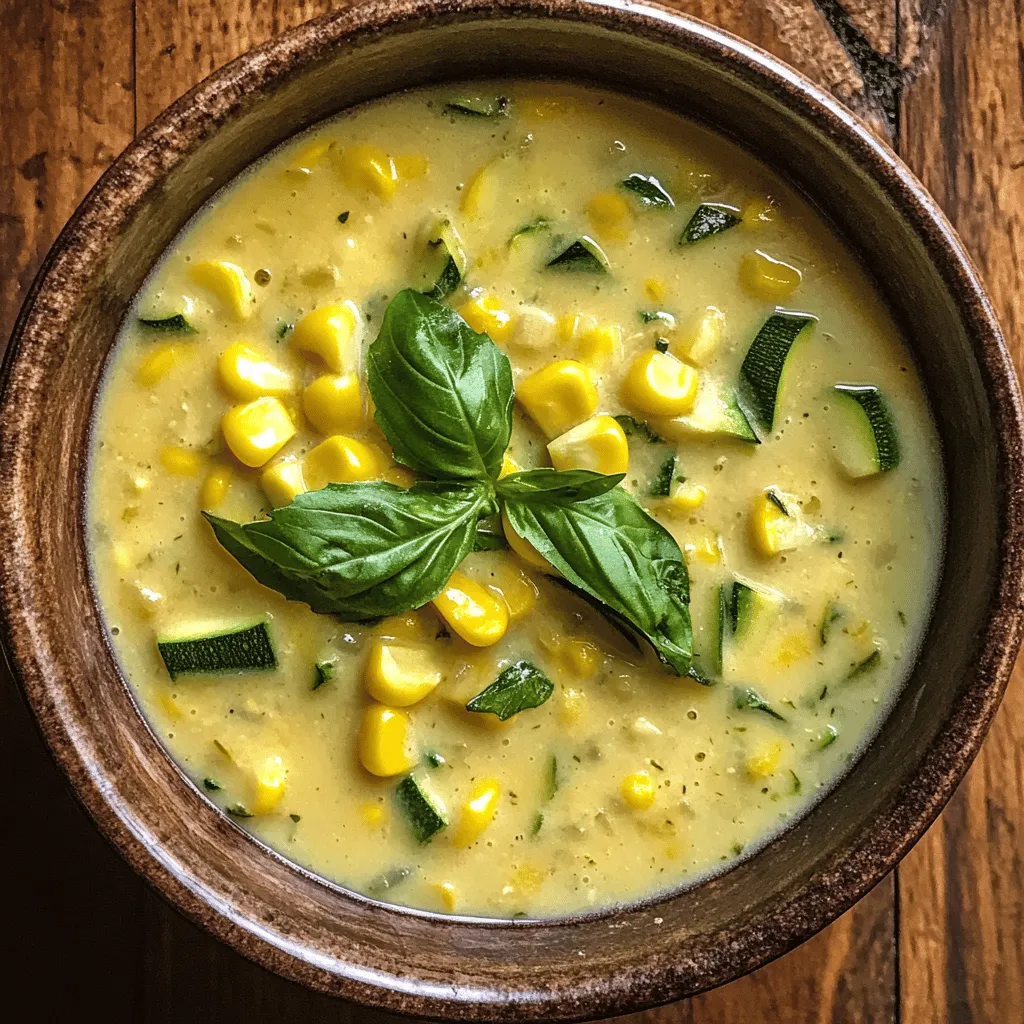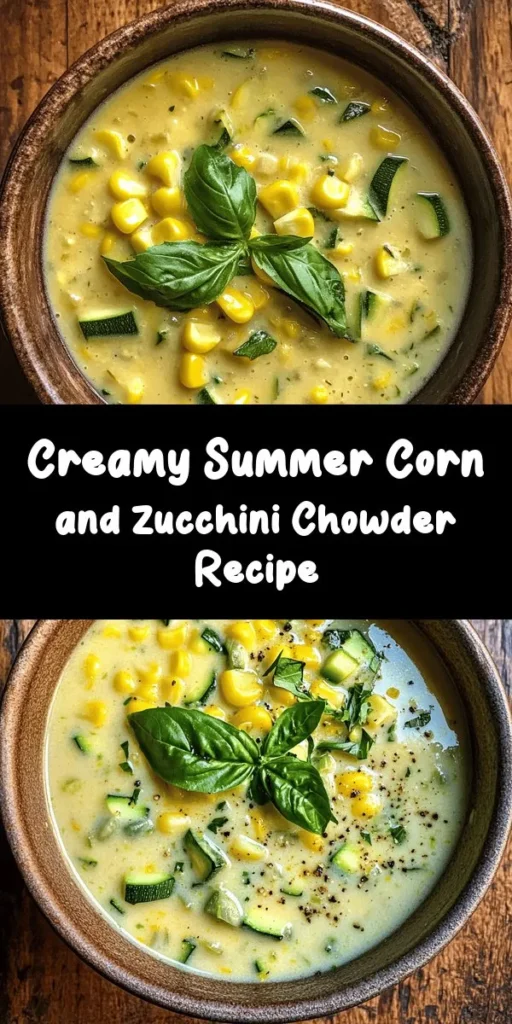As the warm sun shines brightly and farmers’ markets overflow with vibrant produce, summer presents an irresistible opportunity to celebrate fresh, seasonal ingredients. One delightful way to embrace the flavors of summer is by making a delicious Summer Corn and Zucchini Chowder. This creamy, comforting soup showcases the best of summer’s bounty, combining sweet corn and tender zucchini into a dish that is both nourishing and satisfying.
The Appeal of Summer Corn and Zucchini Chowder
Summer Corn and Zucchini Chowder is more than just a soup; it’s a celebration of the season. The natural sweetness of the corn, paired with the mild, slightly nutty flavor of zucchini, creates a harmonious blend that is sure to delight the palate. This chowder is perfect for warm evenings when you want something light yet filling. Whether served as a starter or a main dish, this chowder brings the essence of summer right to your table.
One of the greatest advantages of this chowder is its versatility. You can enjoy it warm or chilled, making it ideal for those hot summer days when you want something refreshing. It can also be easily adapted to accommodate various dietary preferences, whether you’re vegan, vegetarian, or simply seeking a comforting dish that highlights fresh produce.
The Importance of Fresh Ingredients in Summer Cooking
Fresh ingredients are the backbone of any successful summer dish, and this chowder is no exception. The flavor and nutritional value of fresh corn and zucchini far surpass those of their canned or frozen counterparts. Eating seasonal produce not only supports local farmers, but it also encourages you to experiment with the freshest flavors available.
Corn, when picked at the peak of ripeness, is bursting with sweetness and vitamins. Zucchini, often harvested in abundance during the summer months, has a mild flavor that can be complemented by various spices and herbs. By using these fresh ingredients, you’re not just enhancing the taste of your chowder; you’re also boosting its health benefits.
Health Benefits and Flavor Profile of Corn and Zucchini
Both corn and zucchini are packed with essential nutrients that contribute to a healthy diet. Corn is an excellent source of dietary fiber, which aids in digestion and promotes gut health. It is also rich in antioxidants, including lutein and zeaxanthin, which are beneficial for eye health. Zucchini, on the other hand, is low in calories yet high in vitamins A and C, making it a fantastic addition to your summer meals.
Beyond their nutritional benefits, the flavors of corn and zucchini complement each other beautifully. Corn brings a natural sweetness and a satisfying crunch, while zucchini adds a subtle earthiness that rounds out the dish. Together, they create a chowder that is not only healthy but also full of flavor, making it a perfect option for summer gatherings or a cozy family dinner.
Understanding the Ingredients
Creating the perfect Summer Corn and Zucchini Chowder begins with selecting the right ingredients. Below, we’ll dive into the key components that make this dish shine, ensuring that your chowder is both flavorful and nutritious.
Fresh Corn: Nutritional Benefits and Flavor Characteristics
When it comes to corn, freshness is key. Fresh corn on the cob has a naturally sweet flavor that is unmatched by canned or frozen varieties. Look for ears of corn that have bright green husks and plump kernels. The nutritional benefits of corn are significant; it’s a good source of carbohydrates, fiber, and several essential vitamins and minerals, including B vitamins, magnesium, and potassium.
To prepare corn for chowder, you’ll want to shuck the ears and remove the kernels. You can do this by holding the cob upright in a bowl and carefully slicing down the sides with a sharp knife—this method helps catch any stray kernels.
Zucchini: Versatility and Health Benefits
Zucchini is another star ingredient in this chowder. This versatile vegetable is not only easy to prepare, but it also adds a lovely texture and mild flavor that balances the sweetness of the corn. Zucchini is low in calories and high in water content, making it a great addition to summer dishes.
When selecting zucchini, look for ones that are firm and have a vibrant green color. Smaller zucchinis tend to be more tender and flavorful, so opt for those if you can find them. For the chowder, simply wash the zucchini thoroughly and cut it into small, even pieces to ensure even cooking.
Aromatics: The Role of Onion and Garlic in Enhancing Flavor
No chowder is complete without aromatics to build a solid foundation of flavor. Onion and garlic are essential in this recipe, providing depth and richness to the broth. Onions release their natural sweetness when sautéed, while garlic adds a fragrant, savory note that elevates the overall taste of the dish.
For this chowder, you’ll want to use a yellow onion, which offers a balanced flavor that won’t overpower the other ingredients. Finely chop the onion and garlic, preparing them to be sautéed together to create a flavorful base for your chowder.
Vegetable Broth: Importance in Vegetarian Cooking
Vegetable broth serves as the liquid base for this chowder, infusing it with additional flavor and nutrients. It’s an essential component for creating a rich, hearty soup without the need for meat. You can use homemade vegetable broth for the freshest taste or opt for a high-quality store-bought variety to save time.
When choosing vegetable broth, look for options that are low in sodium to control the salt level in your chowder. Additionally, consider broth made from roasted vegetables for an even deeper flavor profile.
Cream Options: Heavy Cream vs. Coconut Milk for Dietary Preferences
The creaminess of the chowder is what makes it so indulgent and satisfying. You have a couple of options when it comes to adding creaminess to your chowder. Traditional recipes often call for heavy cream, which gives the chowder a rich, velvety texture.
For those seeking a dairy-free alternative, coconut milk is an excellent choice. It provides a similar creaminess while adding a subtle hint of sweetness that complements the corn beautifully. Choose full-fat coconut milk for the best consistency, and be sure to mix it well before adding it to your chowder.
Optional Ingredients
– Potatoes for Heartiness and Texture: If you want to add heartiness to your chowder, consider incorporating diced potatoes. They not only add texture but also help thicken the soup naturally. Choose waxy potatoes, such as Yukon Gold or red potatoes, for the best results.
– Fresh Herbs for Garnish: Fresh herbs can elevate your chowder, adding brightness and flavor. Both basil and cilantro work well, but they impart different flavor profiles. Basil offers a sweet, aromatic note, while cilantro adds a fresh, slightly citrusy flavor. Choose one based on your preference or feel free to experiment with both!
Preparation Steps
Now that you have a clear understanding of the ingredients, it’s time to dive into the preparation steps for your Summer Corn and Zucchini Chowder. Below is a detailed breakdown of the cooking process, ensuring that you achieve the perfect balance of flavors and textures.
Sautéing Aromatics: Importance of Cooking Onion and Garlic for Flavor Depth
Begin by heating a generous drizzle of olive oil in a large pot over medium heat. Once the oil is shimmering, add the chopped onion. Sauté the onion for about 5 minutes, or until it becomes translucent and fragrant. This step is crucial as it allows the natural sugars in the onion to caramelize, enhancing the overall flavor of your chowder.
Next, add the minced garlic to the pot. Cook for an additional 1-2 minutes, stirring frequently to prevent the garlic from burning. The aroma that fills your kitchen will be an indication that you’re on the right track!
Incorporating Zucchini and Corn: Techniques for Achieving the Right Texture
Once the aromatics are ready, it’s time to add the chopped zucchini and corn to the pot. Stir them in gently, allowing the vegetables to cook for about 5 minutes. This step helps to soften the zucchini without losing its vibrant color and crunch, while the corn will begin to release its natural sweetness.
For an additional layer of flavor, consider adding some smoked paprika and dried thyme at this stage. These spices will enhance the earthy notes of the chowder and add depth to the overall flavor profile.
Adding Broth and Seasoning: Balancing Flavors with Smoked Paprika and Thyme
After the zucchini and corn have had a chance to soften, it’s time to add the vegetable broth. Pour in enough broth to cover the vegetables—approximately 4 to 6 cups, depending on how thick you want your chowder to be. Stir to combine, and bring the mixture to a gentle simmer.
As the chowder simmers, taste and adjust the seasoning. You can add salt and pepper to enhance the flavors, but remember that you can always add more later if needed. Let the chowder simmer for about 15-20 minutes to allow the flavors to meld and the vegetables to become tender.
Simmering: The Science Behind Cooking Times for Tenderness
Simmering is a key step in the cooking process, allowing the ingredients to soften and the flavors to develop. During this time, the corn will continue to cook, releasing its sweetness into the broth, while the zucchini will become tender yet still maintain a slight bite.
Keep an eye on the pot and stir occasionally to prevent sticking. If you’re using potatoes, be sure to check their doneness as well—we want them to be soft but not mushy.
Cream Incorporation: Techniques for Achieving the Desired Creaminess
Once the vegetables are tender, it’s time to incorporate your chosen cream option. If you’re using heavy cream, slowly pour it into the chowder while stirring to combine. For those using coconut milk, add it in the same manner, allowing the mixture to heat gently without boiling.
This step is crucial for achieving that creamy, luscious texture that makes chowder so comforting. If you prefer an even creamier consistency, you can blend a portion of the chowder using an immersion blender and then stir it back in. This technique helps to create a smooth texture while still keeping some chunks of vegetables for added heartiness.
Blending for Texture: Benefits of Blending and Tips for Achieving the Perfect Consistency
Blending the chowder is a fantastic way to achieve that perfect balance between creamy and chunky. If you’re using an immersion blender, carefully blend the chowder for just a few seconds until you reach your desired consistency. If you prefer a chunkier chowder, be sure to leave some whole pieces of corn and zucchini for texture.
For those without an immersion blender, you can transfer a portion of the chowder to a countertop blender. Just be careful not to overfill the blender jar, as hot liquids can expand. Blend in batches if necessary, and then return the blended soup to the pot.
Now that you have a beautifully creamy, textured chowder, you can give it a final taste and adjust the seasoning as needed. If you’re looking for a little extra brightness, a squeeze of fresh lemon juice can elevate the flavors and add a refreshing twist.
With these preparation steps, you’re well on your way to creating a delectable Summer Corn and Zucchini Chowder that will impress your family and friends. This dish is not only a great way to showcase summer’s freshest ingredients, but it also embodies the comforting essence of home-cooked meals.
Stay tuned for the next section where we’ll explore additional flavor enhancements that will take your chowder to the next level!

Flavor Enhancements with Smoked Paprika and Thyme
In crafting a delicious Summer Corn and Zucchini Chowder, seasoning plays a pivotal role in elevating the dish’s flavor profile. Smoked paprika, a key ingredient in this recipe, adds a subtle smokiness that complements the sweetness of the corn and the earthiness of the zucchini. This spice not only enhances the overall taste but also infuses the chowder with a warm, inviting color. Thyme, on the other hand, introduces a fresh, herbaceous note that balances the richness of the chowder, making each spoonful feel lighter and more refreshing.
For those looking to explore different flavor profiles, there are several alternative seasonings that can be used. For instance, a pinch of cayenne pepper or red pepper flakes can introduce a delightful heat, while a sprinkle of cumin can add an earthy depth. Additionally, Italian seasoning or herbes de Provence can provide a Mediterranean twist, transforming your chowder into a versatile dish that celebrates diverse culinary traditions.
Beyond traditional seasonings, consider enhancing your chowder with a splash of lemon juice or a spoonful of nutritional yeast. Lemon juice brightens the dish, cutting through the creaminess and adding a zesty punch. Nutritional yeast, often beloved in vegan cooking for its cheesy flavor, can provide an umami richness, making the chowder even more satisfying without the need for dairy.
Nutritional Information
When it comes to nutrition, this Summer Corn and Zucchini Chowder is not only delicious but also packed with health benefits. Each serving provides an array of vital nutrients that contribute to a well-balanced diet.
Caloric Breakdown
A typical serving of this chowder contains approximately 250-300 calories, depending on the type of milk used (heavy cream vs. coconut milk). The caloric content is primarily derived from the vegetables, which are low in calories but high in fiber, vitamins, and minerals.
Health Benefits of the Main Ingredients
– Corn: Rich in fiber and antioxidants, corn supports digestive health and may help reduce the risk of chronic diseases.
– Zucchini: Low in calories and high in water content, zucchini is a fantastic source of vitamins A and C, promoting skin health and boosting the immune system.
– Onions and Garlic: These aromatic vegetables are known for their anti-inflammatory properties and can help lower blood pressure and cholesterol levels.
– Coconut Milk: A dairy alternative that provides healthy fats and can aid digestion while being rich in vitamins C, E, and B vitamins.
Comparison of Heavy Cream vs. Coconut Milk
Using heavy cream in chowder can lead to a richer, more indulgent texture but may not be suitable for those watching their calorie or saturated fat intake. On the other hand, coconut milk offers a lighter alternative with a unique flavor profile, making it ideal for vegan diets. While heavy cream has about 52 calories per tablespoon, unsweetened coconut milk contains roughly 45 calories, making it a slightly lower-calorie option. Additionally, coconut milk provides medium-chain triglycerides (MCTs), which may have health benefits such as improved energy levels.
Serving Suggestions
To create a truly memorable dining experience, consider the following serving suggestions that perfectly complement your Summer Corn and Zucchini Chowder.
Ideal Pairings
This chowder is versatile and pairs well with a variety of sides. For a classic touch, serve it alongside crusty artisan bread or homemade garlic bread. The bread’s texture and flavor provide a delightful contrast to the creamy chowder.
Side Salads
Enhance your meal with a refreshing side salad. A simple mixed greens salad dressed with lemon vinaigrette or a cucumber and tomato salad adds crispness and balances the chowder’s creaminess. Alternatively, a quinoa salad with fresh herbs can provide an extra layer of nutrition and flavor.
Presentation Tips
Presentation can elevate your chowder from simple to stunning. Serve the chowder in vibrant bowls and garnish with a sprinkle of fresh herbs, a drizzle of olive oil, or a few kernels of corn. This not only makes for an appealing visual but also adds an additional burst of flavor with each serving.
Storage and Reheating
Proper storage and reheating techniques are essential for maintaining the chowder’s flavor and texture.
Best Practices for Storing Leftover Chowder
Allow any leftover chowder to cool completely before transferring it to an airtight container. Store in the refrigerator for up to 3-4 days. For longer storage, consider freezing the chowder in portions. Use freezer-safe containers or bags, leaving some space for expansion, as liquids can swell when frozen.
Tips for Reheating
When reheating, take care to preserve the chowder’s creamy consistency. Avoid boiling the chowder, as this can cause separation. Instead, reheat gently on the stove over low heat, stirring frequently. If the chowder appears too thick after refrigeration, add a splash of vegetable broth or water to achieve the desired consistency.
Shelf Life
In the refrigerator, the chowder lasts about 3-4 days. If frozen, it can remain safe for consumption for up to 2-3 months. For the best quality, consume it within this timeframe, as prolonged freezing can affect texture and flavor.
Cultural Context and Variations
Chowder, in its various forms, has a rich history and cultural significance across different cuisines.
Exploration of Chowder
Traditionally associated with coastal regions, chowder has roots in French and English culinary practices. The word “chowder” is believed to derive from the French term “chaudière,” meaning cauldron, where fishermen would cook their catches with local ingredients. In the United States, the New England clam chowder has become particularly iconic, but variations using different proteins and vegetables are celebrated in many cultures.
Variations for Dietary Needs
This Summer Corn and Zucchini Chowder can be easily adapted to meet various dietary requirements. For a vegan version, simply replace the heavy cream with coconut milk or cashew cream. Gluten-free diners can enjoy this chowder without concern, as it’s naturally gluten-free when made with fresh ingredients.
Seasonal Adaptations
The beauty of this chowder lies in its adaptability to seasonal vegetables. As summer fades into autumn, consider incorporating other produce such as carrots, bell peppers, or even spinach. This not only celebrates seasonal abundance but also diversifies the flavors and nutritional profile of your dish.
Conclusion
This Summer Corn and Zucchini Chowder is not just a comforting meal; it embodies the essence of summer through its fresh, seasonal ingredients. The combination of sweet corn, tender zucchini, and vibrant spices creates a dish that is both nourishing and satisfying. By embracing the use of seasonal produce and exploring various flavor enhancements, you can create a chowder that is uniquely yours.
Whether enjoyed as a light lunch or a hearty dinner, this chowder is sure to impress. As you experiment with different variations, don’t hesitate to include your favorite vegetables and seasonings. So this summer, gather your ingredients, and embark on a culinary journey with this delightful chowder that celebrates the season’s bounty. Enjoy the process, share with loved ones, and savor each delicious bite.



